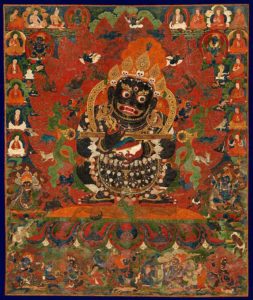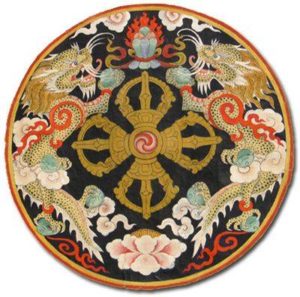金剛力士
The Vajra-Warrior
______________________________________________

大慧!變化如來,金剛力士常隨衛護,非真實佛。真實如來,離諸限量,二乘 外道,所不能知,住現法樂,成就智忍,不假金剛力士所護。
-大乘入楞伽經
Great Wisdom! Transformative Tathagata [1], the Vajra-Warrior constantly abides by [his] protection [against what] is the non-real Buddha. The real Tathagata separates from all limitations , and [any] Dao [2] outside from the Second Vehicle [3]. That which one is unable to be aware of resides and manifests in the joy of the Dharma, bringing about wisdom and tolerance, not forging that which the Vajra-Warrior’s protects.
-Lankavatara Sutra
______________________________________________
Vajra, by and large, is revered as the protector deity and patron saint of the Buddha, the Dharma [4] and the Sangha [5], known as the Three Jewels [fo fa seng佛法僧]. The most common translation of his name is Diamond Warrior and less frequently Adamantine Warrior.
First it is note-worthy to further analyse the word Vajra [jin gang金刚]. The Vajra or Vajra-Pestle [jn gang chu金刚杵] is a Sanskrit term, which in Tibetan is called Multi-fold Auspice [duo ji多吉]. Moreover, it is also called Producing-Jewels-Pestle [zuo bao chu 做宝杵] or Subduing Demons Pestle [xiang mo chu降魔杵]. This word’s origin comes from a weapon from ancient India. Due to its quality being firm and stable it is able to strike and smash any type of object, which is the reason why it is named Vajra-Pestle, or Adamantine-Pestle.
In a more detailed view, Vajra [jin gang金剛] within the Buddhist ancient books is actually a collective term for many Protector Deities of the Buddhist Dharma such as the Four Great Vajras [si da jin gang四大金剛], the Eight Great Vajras [八大金剛] and even the Twenty Various Heavens [er shi zhu tian 二十諸天]. All of them are frequently referred to as Vajras. According to one legend Vajra is a guardian of the Heavenly Realm [tian jie天界]. He is also characterized as Shakyamuni’s attendant and foremost personal aide, and according to some accounts the attendant of all Buddhas. His alternative names are the Spirit of the Vajra of Great Powers [da li jin gang shen大力金剛神] or Vajra-Powers Ghost-Spirit [jin gang li gui shen 金剛力鬼神]. In esoteric Buddhism he is one of the Thirty-Seven Revered Ones [ san shi qi zun zhi yi三十七尊之一] from the Diamond Realm [jin gang jie金刚界], one of the Sixteen Great Bodhisattva [da pu sa zhi yi 大菩萨之一], and one of the Four Directions Boundless Life Tathagata Four Closest Disciples [ru lai si qin jin zhi yi 如来四亲近之一].
In addition, the《Benevolent King’s Protection of the Country’s Prajna Paramita Sutra》[ren wang hu guo bo re bo luo mi jing 仁王护国般若波罗蜜经] lists five Vajras as the Bodhisattvas of the Five Directions [wu fang pu sa 五方菩萨], namely Buddha’s Warrior Attendant Protector of the East, Vajrapani [jin gang shou金刚手], Buddha’s Warrior Attendant Protector of the South, Vajraratna [jin gang bao金剛宝], Buddha’s Warrior Attendant Protector of the West, Vajratiksna [jin gang li 金剛利], Buddha’s Warrior Attendant Protector of the North, Vajrayaksa [jin gang yao cha金剛薬叉], and lastly Buddha’s Warrior Attendant Protector of the Middle, Vajraparamita [jin gang bo luo mi duo金剛波羅蜜多]. They are portrayed as the protectors of countries whose kings uphold Buddhism.
According to another legend in the《Maharatnakuta Sūtra》[da bao ji jing大寶積經], the Secret-Traces Vajra, Guhyapada , is believed to be the transformation of the Skanda [6]. Following this pertaining legend he changed into the temples’ door guardians- the Two Vajra Warriors. Those two are the most famous and commonly seen protector deities of the Buddhist Dharma within Buddhist temples, also titled the Two Benevolent Kings [liang da ren wang 兩大仁王] standing guard by the Buddha’s side. Amongst the populace they are known by the name of the Two Generals Heng & Ha [7] [heng ha er jiang哼哈二將].
Commonly it is said, that the Vajra-Warrior on the left-side, since closing his mouth, represents the Om-shape [hong xing吽形], whereas the one on the right, since opening his mouth, represents the A-shape [a xing阿形]. In Chinese legend, the closed mouth Om- shape is called Heng [哼], his Indian name is Narayana [na luo yan jing gang那羅延金剛]. The open mouthed A-shape is called Ha [哈], or by its Indian name Guhyapada [mi ji jin gang密跡力士], forming the Two Generals Heng and Ha [二将哼哈]. Both of the above-mentioned Indian deities appear within the Thousand-Hands Guan Yin’s Twenty-Eight Troop Divisions [qian shou guan yin er shi ba bu zhong千手觀音二十八部眾], which are deities of different directions; namely Narayana as her right helper and Guhyapada as her left assistant [8].
Lastly, it is warranted to point out that the Buddha’s Warrior Attendant’s name has been eternalised by naming a Tai Ji Fist movement after him, namely The Warrior Attendant Pounds the Mortar [jin gang dao zhui [金刚捣碓, a stance originating from Chen-style Tai Ji. It also appears in the Heavenly Horse Tai Ji Fist Form [tian ma tai ji quan tao lu 天马太极拳套路], referred to as Pounding the Medicine in the Moon Palace [dao yao guang han 捣药广寒].

[1] Tathagata is a honorific title of the Buddha, often translated as The One who has to Come [ru lai 如来].
[2] Dao in this instance broadly stands for the path one takes.
[3] The Second Vehicle [er cheng 二乘] is also called the Great Vehicle [da cheng 大乘] and is interchangeable with Mahayana Buddhism.
[4]Dharma [fa法] are the laws and teaching of Buddhism.
[5] Sangha [seng僧] is the Sanskrit word for the Buddhist community.
[6] Skanda [wei tuo韦驼] is a Bodhisattva in Mahayana Buddhism, who is worshipped as guardian of Buddhist monasteries and protector of the Buddhist teachings. Thus, his honorific title is Protector of the Dharma Wei Tuo Revered Heavenly Bodhisattva [hu fa wei tuo zun tian pu sa 护法韦驼尊天菩萨].
[7] The Two Generals Heng & Ha [哼哈二将] are also known by the names of the Two Heavenly Kings [er tian wang二天王], the Two Heavenly [Ones] [er tian二天] and the two Kingly Revered Ones [er wang zun二王尊].
[8] It is worth the reader’s attention that the two extra stars protecting the entrance at the ladle of the Seven Stars of the Big Dipper are named External Assistance [wai fu外辅] and Internal Helper [nei bi内弼], hence, constituting the Nine Stars of Daoism.
______________________________________________
Post-Scriptum: This article will appear in the appendix of Purple Cloud Press’ forthcoming publication of 《The 49 Barriers of Daoist Cultivation》 by Xing De, a manual for refining Inner Nature based on Liu Yiming’s 50 Barriers.
2 Comments
Leave a Comment
You must be logged in to post a comment.

I have not had this feedback from anybody else.
This was done with the help of a webdesigner.